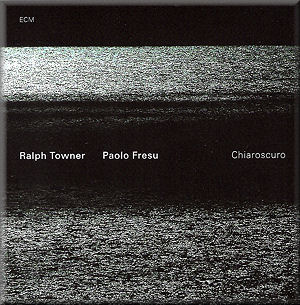1. Wistful Thinking
2. Punta Giara
3. Chiaroscuro
4. Sacred Place
5. Blue in Green
6. Doubled Up
7. Zephyr
8. Sacred Place (reprise)
9. Two Miniatures
10. Postlude
Ralph Towner - Classical, 12-string and baritone guitars
Paolo Fresu - Trumpet, flugelhorn
The title of this new CD, Chiaroscuro, means "bright
and dark". Originally applied to a style of painting which emphasised
contrasting light and shadow, it might well describe this album, which
consists of both bright and subdued music. But the predominant mood
is muted, with no up-tempo tracks and a general feeling of quiet contemplation.
This seems typical of many recent ECM releases, where the Scandinavian
style of understatement increasingly seems to prevail. However, these
duettists are not Scandinavians. Guitarist Ralph Towner is an American
who now lives in Italy, and trumpeter Paolo Fresu is from Sardinia.
The combination of guitar and trumpet (or flugelhorn) is unusual,
to say the least and you might expect it to present some problems,
such as the trumpet overpowering the guitar. However, Paolo generally
plays quietly, with only occasional louder outbursts, and he is beautifully
accompanied by Ralph Towner, whose solo work is also first-class.
On a variety of acoustic guitars, Ralph is able to sound like a whole
orchestra - albeit a subdued and subtle one. He has already shown
himself a master of understatement with the group Oregon and his deliacte
playing here is a constant pleasure.
Paolo Fresu makes no secret of his admiration for Miles Davis, and
his trumpet style is very reminiscent of Miles - especially in the
album's only non-original: Blue in Green, composed by Miles
Davis and Bill Evans. Ralph Towner wrote seven of the other tunes,
and co-wrote the last two with Fresu. You might call the tunes "ballads",
except that they are mostly out-of-tempo and don't have readily identifiable
melodies. In fact this is a long way from conventional jazz that makes
you tap your foot. All the tracks seem like meditations rather than
tunes - and there's nothing wrong with that, although the sameness
of the styles can become monotonous for anyone seeking variety of
approach.
Nonetheless, this doesn't prevent the music being enchanting, as
the free rhythm and slow tempos allow the musicians to show their
lyrical sides. The last two tracks appear to be free improvisation
but they demonstrate the empathy between the two musicians.
Tony Augarde
